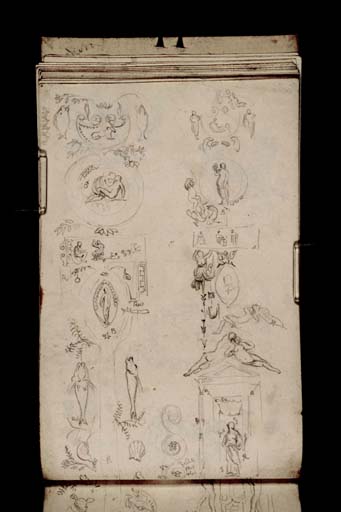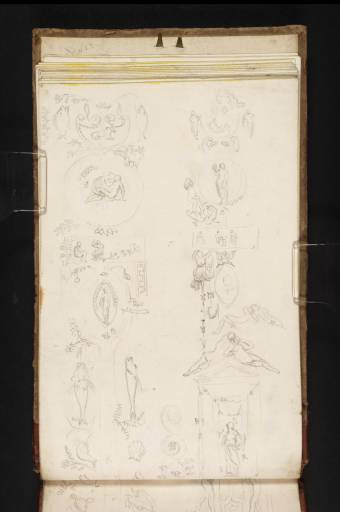Joseph Mallord William Turner Details of the Decorations of Raphael's Loggia in the Vatican: the Third and Fourth External Piers 1819
Image 1 of 2
-
 Joseph Mallord William Turner, Details of the Decorations of Raphael's Loggia in the Vatican: the Third and Fourth External Piers 1819
Joseph Mallord William Turner, Details of the Decorations of Raphael's Loggia in the Vatican: the Third and Fourth External Piers 1819 -
 Joseph Mallord William Turner, Details of the Decorations of Raphael's Loggia in the Vatican: the Third and Fourth External Piers 1819 (Enhanced image)Enhanced image
Joseph Mallord William Turner, Details of the Decorations of Raphael's Loggia in the Vatican: the Third and Fourth External Piers 1819 (Enhanced image)Enhanced image
Joseph Mallord William Turner,
Details of the Decorations of Raphael's Loggia in the Vatican: the Third and Fourth External Piers
1819
Joseph Mallord William Turner 1775–1851
Folio 18 Verso:
Details of the Decorations of Raphael’s Loggia in the Vatican: the Third and Fourth External Piers 1819
D14962
Turner Bequest CLXXIX 18 a
Turner Bequest CLXXIX 18 a
Pencil on white wove paper, 186 x 112 mm
Inscribed by the artist in pencil with various notes on Raphael’s loggia [see main catalogue entry]
Inscribed by the artist in pencil with various notes on Raphael’s loggia [see main catalogue entry]
Accepted by the nation as part of the Turner Bequest 1856
References
1909
A.J. Finberg, A Complete Inventory of the Drawings of the Turner Bequest, London 1909, vol.I, p.527 as ‘Decorations of the Logge’.
1965
Jerrold Ziff, ‘Copies of Claude’s Paintings in the Sketch Books of J.M.W. Turner, Gazette des beaux-arts, vol.65, January 1965, pp.56, 64 note 24.
1974
Martin Butlin, Andrew Wilton and John Gage, Turner 1775–1851, exhibition catalogue, Royal Academy, London 1974, p.92 under no.236.
1979
Andrew Wilton, The Life and Work of J.M.W. Turner, Fribourg 1979, p.147.
1982
Evelyn Joll and Martin Butlin, L’opera completa di Turner 1793–1829, Classici dell’arte, Milan 1982, p.107 under no.228.
1982
Cecilia Powell, ‘Exhibition Review: Turner’s First Visit to Italy in 1819’, Turner Studies, Summer 1982, vol.2, no.1, p.48.
1984
Martin Butlin and Evelyn Joll, The Paintings of J.M.W. Turner, revised ed., New Haven and London 1984, p.137 under no.228.
1984
Cecilia Powell, ‘Turner on Classic Ground: His Visits to Central and Southern Italy and Related Paintings and Drawings’, unpublished Ph.D thesis, Courtauld Institute of Art, University of London 1984, pp.148, 151 note 2, 235.
1987
Robert E. McVaugh, ‘Turner and Rome, Raphael and the Fornarina’, Studies in Romanticism, no.26, Autumn 1987, pp.371–2.
1987
Cecilia Powell, Turner in the South: Rome, Naples, Florence, New Haven and London 1987, p.65 note 1.
1997
James Hamilton, Turner: A Life, London 1997, p.205 note 1.
1998
James Hamilton, Turner and the Scientists, exhibition catalogue, Tate Gallery, London 1998, p.68.
2009
Ian Warrell, ‘Painters Painted: The Cult of the Artist’, in David Solkin (ed.), Turner and the Masters, exhibition catalogue, Tate Britain, London 2009, p.229 note 1 under no.63.
2010
David Solkin and Guillaume Faroult (eds.), Turner et ses peintres, exhibition catalogue, Galeries nationales, Grand Palais, Paris 2010, pp.196, 262 note 12.
2011
Nicola Moorby, ‘Turner’s Sketches for “Rome from the Vatican”: Some Recent Discoveries’, Turner Society News, no.115, Spring 2011, pp.5, 10 notes 15, 16 and 20.
The sketches on this page relate to Turner’s painted recreation of the loggia on the right-hand side of Rome from the Vatican. Raffaelle Accompanied by La Fornarina, Preparing his Pictures for the Decoration of the Loggia exhibited 1820 (Tate, N00503).1 They depict the fresco and stucco decorations on the third and fourth external piers of the Loggia of Raphael and comprise two distinct groups, from left to right:
a
On the left-hand side of the page are details of the stucco and grotesque decorations from the upper part of the lateral side (right-hand, or northern, as you are looking at the interior wall) of the third external pilaster (i.e. the pillar between the second and third window from the end). The stucco medallions comprise, from top to bottom: a lion; two lovers; a scene of sacrifice; and a man;2 whilst the grotesque decorations incorporate fish, shells and other marine motifs. The sketch is variously annotated with colour notes, from top to bottom, ‘R’, ‘Red’, ‘Yell’, ‘B’, ‘P W’, ‘Red’, ‘R’ ‘Y’ and ‘Y’.
On the left-hand side of the page are details of the stucco and grotesque decorations from the upper part of the lateral side (right-hand, or northern, as you are looking at the interior wall) of the third external pilaster (i.e. the pillar between the second and third window from the end). The stucco medallions comprise, from top to bottom: a lion; two lovers; a scene of sacrifice; and a man;2 whilst the grotesque decorations incorporate fish, shells and other marine motifs. The sketch is variously annotated with colour notes, from top to bottom, ‘R’, ‘Red’, ‘Yell’, ‘B’, ‘P W’, ‘Red’, ‘R’ ‘Y’ and ‘Y’.
b
On the right-hand side are details of the stucco and grotesque decorations from the upper part of the facing (front) side of the fourth external pilaster (i.e. the pillar between the third and fourth window from the end). The stucco medallions comprise, from top to bottom: a reclining woman with a cornucopia; a figure with a Medici ring; a scene from the legend of Muzio Scevola; and a portrait head.3 The lower grotesque decorations meanwhile incorporate two nude figures lying above a pediment and a classical goddess.4 Turner has inscribed the study with various colour notes, from top to bottom, ‘B’, ‘B’, ‘P’, ‘P Y’, ‘G’, ‘Yell’, ‘R’, ‘G’ and ‘Purple’, and, amidst the decorative scroll motif at the bottom ‘Yellow | Pier | Flow’.
On the right-hand side are details of the stucco and grotesque decorations from the upper part of the facing (front) side of the fourth external pilaster (i.e. the pillar between the third and fourth window from the end). The stucco medallions comprise, from top to bottom: a reclining woman with a cornucopia; a figure with a Medici ring; a scene from the legend of Muzio Scevola; and a portrait head.3 The lower grotesque decorations meanwhile incorporate two nude figures lying above a pediment and a classical goddess.4 Turner has inscribed the study with various colour notes, from top to bottom, ‘B’, ‘B’, ‘P’, ‘P Y’, ‘G’, ‘Yell’, ‘R’, ‘G’ and ‘Purple’, and, amidst the decorative scroll motif at the bottom ‘Yellow | Pier | Flow’.
Both drawings are continued on the opposite sheet of the double-page spread with the lower section of the pilasters, see folio 19 (D14963).
The decorations on the lateral side of the third pilaster appear in Rome from the Vatican to the immediate right of the foreground figure of Raphael. The details from the bottom of the fourth external pilaster, meanwhile, can be seen on the far left-hand side of the composition, dominating the full height of the picture space. Further studies related to the evolution of Rome from the Vatican can be found on folios 13 verso–18, 19–21 verso and 25–26 (D14955–D14962, D14963–D14966 and D14970–2), as well as an elaborate compositional drawing in pen and ink in the Rome C. Studies sketchbook (Tate D16368; Turner Bequest CLXXXIX 41). For a full description of the loggia and Turner’s sketches see folio 14 (D14956).
Turner also re-used the grotesque design from the third pilaster within another, later, finished oil painting, The Golden Bough exhibited 1834 (Tate, N00371).5 The lateral side of the pilaster featuring the fish motifs appears within a wall on the far left-hand side of the composition. This may reflect the Claudian spirit of the picture, employing the seventeenth-century artist’s practice of creating an idealised vision of Italy made up of composite parts.6 The picture incorporates a number of other references from Turner’s 1819 tour of the country, for example a classical building resembling the Temple of Clitumnus in Umbria, a lake surrounded by hills similar to Lakes Albano and Nemi, and fragments of antique sarcophagi such as those which the artist sketched in the Vatican Fragments sketchbook (Tate; Turner Bequest CLXXX).
Nicola Moorby
January 2010
Martin Butlin and Evelyn Joll, The Paintings of J.M.W. Turner, revised ed., New Haven and London 1984, no.228.
See Nicole Dacos, Le Logge di Rafaello: Maestro e bottega di fronte all’antico, Rome 1977, p.266, reproduced Tav.CIII, as ‘b) Pilastro IV.A, esterno’. The design is repeated on the opposite side of the window.
How to cite
Nicola Moorby, ‘Details of the Decorations of Raphael’s Loggia in the Vatican: the Third and Fourth External Piers 1819 by Joseph Mallord William Turner’, catalogue entry, January 2010, in David Blayney Brown (ed.), J.M.W. Turner: Sketchbooks, Drawings and Watercolours, Tate Research Publication, December 2012, https://www

